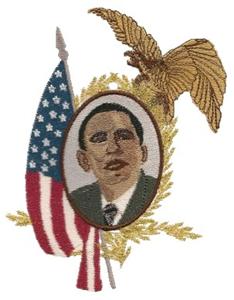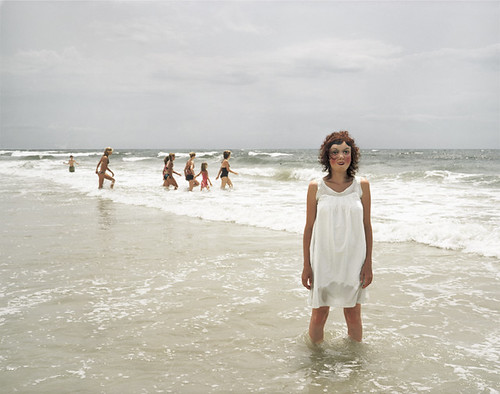I have belatedly learned that KAWS was featured recently on, of all things, CBS Sunday Morning. See the video clip on Freshnessmag. Evidently the crew visited his studio back in October. In other news, the artist’s L.A. show at Honor Fraser is coming up on February 21. August 3, 2008 Consumed on KAWS is here.
Recently passed away: Jack Cover, inventor of the Taser. A May 18, 2008 Consumed about Taser’s adoption of more fashionable designs to appeal to mainstream consumers appeared is here. Interesting obit detail:
He got the name for the weapon from one of his favorite childhood books, “Tom Swift and His Electric Rifle,” one in a popular early 20th century series by Victor Appleton. In the book, the young Swift invents a rifle that shoots bolts of electricity. The story apparently continued to animate Cover’s imagination decades later, when he conceived the word “Taser” as an acronym for “Thomas A. Swift Electric Rifle.” (Cover evidently added the middle initial “A,” which does not appear in the books.)
And in new links on the roll news: Adding The Entrepreneurial Agenda by friend and former colleague Robb Mandelbaum.
 … but, for reasons that would take too long to explain, I was just on a site called Embroidery.com, and was surprised to see that the “most popular” embroidery pattern on offer was, yes, “President Obama Commemorative Embroidery.” Or “POOBAMA 1,” as the product reference code puts it.
… but, for reasons that would take too long to explain, I was just on a site called Embroidery.com, and was surprised to see that the “most popular” embroidery pattern on offer was, yes, “President Obama Commemorative Embroidery.” Or “POOBAMA 1,” as the product reference code puts it.
Here is an image from a Flickr set called The Maggie Project. Seems to be a series of images of a woman wearing a fairly creepy mask in a variety of situations. It’s quite interesting and I recommend taking a look.
Apparently these images were taken by Ofer Wolberger. The Flickr set includes an official statement that begins: “Photography has been a vehicle with which to examine notions of beauty and identity, conflicts of self perception and representation, and the role that visual culture plays in both. This exploration is expanded in (Life with) Maggie, by a fictional character who seems transported from another time and place, one presumably set in the past.” It continues in this unenlightening mumbo-jumbo vein for several paragraphs. I have no idea what any of it is supposed to mean.
However, again, the actual images are very compelling.
Via The Storque.
According to Brandweek:
“There’s a financial cry in the country right now — and that’s going to translate into shopping,” says Karen Bard, the resident pop-culture expert for online auction site eBay. Bard’s not talking about how much people are spending so much as what they’re buying. Sales of just about anything related to the Great Depression have been surging since Christmas. In the last three months, eBay’s category “Depression Era” has seen a 15 percent increase in sales traffic, with specific spikes recorded for 1930s music (up 8 percent) and cloche hats (up 65 percent). At Amazon, December 2008 sales of Depression-related titles (including The Great Crash, The Forgotten Man and Ben Bernanke’s Essays on the Great Depression) were up by a whopping 750 percent (the company does not disclose unit sales).
Depression momentum started building just before the holiday shopping rush-which was, not coincidentally, the same time that bad news about the economy began to feel merely like harbingers of far worse. Between September and October, Netflix recorded a 10 percent rise in rentals of The Grapes of Wrath.
 FAIL WIN
FAIL WIN
An unlikely social-media icon
This week in Consumed, how a service-interruption image got a fan base — as if a song heard mostly as hold music hit the Billboard charts.
As with many Web-popularity stories, there’s a lot of flukiness to Fail Whale’s rise. For starters, Lu had never heard of Twitter when she created the image (which she called Lifting Up a Dreamer) as an electronic birthday card for a friend overseas while she was still finishing her visual communications degree at the University of Technology, Sydney. In July 2007, she uploaded a number of her illustrations, including that one, to a service called iStockphoto. That’s where, almost a year later, it came to the attention of Biz Stone, a Twitter founder….
It probably took two specific factors to create the accidental icon. First, it’s a lesson in the power of raw repetition — the “mere exposure effect” identified by psychology studies that suggests we like things more simply by seeing them more often. Second, Twitter enthusiasts are almost alarmingly zealous….
Read the column in the February 15, 2009, issue of The New York Times Magazine, or here.
Consumed archive is here, and FAQ is here. The Times’ Consumed RSS feed is here. Consumed Facebook page is here.
“Letters should be addressed to Letters to the Editor, Magazine, The New York Times, 620 Eighth Avenue, 6th Floor, New York, N.Y. 10018. The e-mail address is magazine@nytimes.com. All letters should include the writer’s name, address and daytime telephone number. We are unable to acknowledge or return unpublished letters. Letters may be edited for length and clarity.”

Randomly encoutnered on the Web site of Handmade Galleries, L.A.: Thumb wrestling masks.
Maybe these are old news. I don’t care.
Here is the second in The Murketing Organization’s series (explained earlier) of occasional mini-portfolio/short Q&As, relating to a particular set discovered on Flickr that has some relationship to this site’s subject matter. Once again Tom Hosford, of Washington & Lee University handles Q&A duties, this time interviewing the photographer who created this set of Vernacular Typography Polaroids. (This Q&A was delayed due to my technical difficulties; apologies to both interviewer and interviewee.) Take it away, Tom…
This set features the work of designer/photographer Douglas Wilson, who traveled across the U.S. and documented the hand-painted signs he encountered along the way. His Polaroids captured a broad range of communities, each represented by the signs they possessed. — Tom Hosford
Q: From looking at these photos, it seems like you’ve managed to see a lot of states across the U.S. Were you in these places for any given reason, or did you just want to explore small towns across America?
A: Simply put, I love traveling. I have been blessed to visit 48 of the 50 United States (minus Alaska and Idaho). Many of my Polaroids were taken driving to visit my wife’s family in Jackson, Mississippi. To get there, we have to drive through many small towns in Missouri and Arkansas and they have some pretty amazing hand-painted signs. I have to admit that many times, I have turned the car around just to photograph a particular sign — you never know when these signs will be painted over or replaced!
What made you to decide to document your travels through photographing local signs, instead of landmarks, people, etc.?
Please continue…
During my technical-difficulties hiatus I was unable to mention the Times Magazine cover story, “The Big Fix,” about the various plans to revive the economy and so on. There’s much in it that’s worth reading if you haven’t already. The one thing I wanted to highlight here is a bit toward the end.
Economists don’t talk much about cultural norms. They prefer to emphasize prices, taxes and other incentives.
[But] the norms of the last two decades or so — consume before invest; worry about the short term, not the long term — have been more than just a reflection of the economy. They have also affected the economy.
Most of the examples that follow are other-directed: greedy CEOs, corrupt technocrats, etc. “Consume before invest” has been a grass-roots cultural norm, too, no? Writer David Leonhardt addresses that side of the equation somewhat indirectly, with this finding:
Towns and cities with a large elderly population once devoted a higher-than-average share of their taxes to schools. Apparently, age made them see the benefits of education.
In recent decades, though, the relationship switched. Older towns spent less than average on schools. You can imagine voters in these places asking themselves, “What’s in it for me?”
One interesting cultural-norm question is whether “What’s in it for me?” is changing or not. I think the evidence is mixed.
Handmade Nation onslaught now underway. Summary of NY events on The Storque:
There will also be a panel discussion at the Powerhouse Arena Bookstore in Brooklyn on Wednesday, February 11, 7-9pm EST. Powerhouse is located at 37 Main Street, Brooklyn, NY 11201
Faythe Levine and Cortney Heimerl, co-authors of “Handmade Nation,” join American Craft Editor-in-Chief Andrew Wagner and KnitKnit‘s Sabrina Gschwandtner for a panel on art, craft and design.
Another panel discussion tomorrow night, with Faythe Levine, Mandy Greer, Kate Bingaman-Burt and Callie Janoff, is sold out, but will be videostreamed in Etsy; details here.
Posted Under:
DIYism,
To Do by Rob Walker on February 11, 2009
Comments Off on To do in NYC tonight
I’ve never really given TED much thought until this year. Maybe it’s just me, but I feel like TED-hype is everywhere. Virginia Postrel was there of course, and notes:
On the last day, curator Chris Anderson addressed critics* who complained that the conference was ignoring the global economic crisis. His main point was to maintain long-term perspective, arguing–with a Keynes quote–that TED engages the ideas that create a better future once the gyrations of the moment are over.
Postrel has a pretty good comeback on that. But I bring this up because I wonder if, critics aside, the optimism isn’t exactly the reason that there’s so much TED-mania, online at least. Enough with the grim economic numbers! Let’s groove on some cockeyed optimism about creativity and technlogy! Let’s get inspired!
That kind of thing.
[*Update: Here‘s what he said.]
Posted Under:
Flickr Artifacts by Rob Walker on February 9, 2009
Comments Off on Flickr Interlude
I guess this WSJ “Outlook” column is available only to subscribers, but it’s pretty interesting. Writer Justin Lahart compares the current economic moment to 1980. Back then, Fed actions radically tightened credit in attempt to snap brutal inflation, and that medicine entailed a huge blow to consumer spending:
The credit controls had an immediate effect on behavior. Sales fell sharply and companies shed workers at an alarming rate, with the economy losing a million jobs between April and June. Final sales, a measure of overall economic demand, fell by an inflation-adjusted 7.5% in the second quarter — a drop even steeper than the 5.2% decline final sales registered in the fourth quarter last year.
The interesting part is that that when the Fed ligthened up a few months later, “economists had little hope that a recovery would happen anytime soon. The Fed agreed, forecasting that the economy would contract for the rest of the year.” But they were wrong. Almost immediately, pent-up demand spilled into spending: “With the credit crunch over, consumers and companies raced to buy what they had held off on. Final sales rose 5.4% in the third quarter, and a further 3.6% in the fourth.”
Such rebounds are actually the norm. Of the 10 largest quarterly drops in final sales over the past 50 years, nine were followed by rebounds the following quarter, with an average gain of 5.4%. The chance of any rebound in the current quarter seems far-fetched after last week’s dismal reports on January manufacturing activity, chain-store sales and jobs. Still, if the government’s coming stimulus package and bank plan are able to restore a modicum of confidence in the economy, recovery could come surprisingly quickly.
Is that an overly optimistic scenario? Perhaps. Savings rates were a lot higher going into that 1980 period than they were going into the fourth quarter of 2008. And there seem to be so many interwoven factors now, it’s just hard to believe in a quick rebound of any kind. Then again, people were pretty pessimistic back in 1980s, too.
Anyway, the truth is that Lahart’s comparison to the early 1980s isn’t really that optimistic.
The economic expansion that followed the 1980 recession was one of the briefest on record. Rampant inflation and overdependence on a manufacturing sector facing stiff foreign competition were still problems, and by mid-1981 the economy was careening into the longest downturn since the Great Depression. After years of heavy dependence on credit-fueled spending, a quick recovery for today’s economy could also prove fleeting.
Okay, so that’s not very cheery. But it’s nice to have some historical perspective just the same.
 Craftzine notes that Margaux Lange, whose Barbie-parts jewelry was the subject of this January 22, 2009 Consumed, has accessorized a Barbie with her work, for an exhibition in connection with Paris’s “fashion week.” As noted earlier, Barbie turns 50 this year, and I expect we’ll see much much Barbie-ness in the months ahead. Designboom offers up a huge gallery of images, including many of the manufacturing process. And Lange herself points out the work of Jocelyn Grivaud, who casts Barbie in various famous art images by the likes of Vermeer and Man Ray. Interestingly, Grivaud also casts Barbie in Warhol’s Marilyn Monroe portrait; Warhol, of course, actually did a Barbie portrait.
Craftzine notes that Margaux Lange, whose Barbie-parts jewelry was the subject of this January 22, 2009 Consumed, has accessorized a Barbie with her work, for an exhibition in connection with Paris’s “fashion week.” As noted earlier, Barbie turns 50 this year, and I expect we’ll see much much Barbie-ness in the months ahead. Designboom offers up a huge gallery of images, including many of the manufacturing process. And Lange herself points out the work of Jocelyn Grivaud, who casts Barbie in various famous art images by the likes of Vermeer and Man Ray. Interestingly, Grivaud also casts Barbie in Warhol’s Marilyn Monroe portrait; Warhol, of course, actually did a Barbie portrait.
As you know, this site was unavailable for a while, so this update is old, but perhaps you noticed that Obama likes Honest Tea, which was a Consumed subject July 3, 2005. C’mon, you know Obama reads Consumed.
You may also have seen the news that Zune sales got whacked on the holidays; the Zune minority was the subject of this August 8, 2008 Consumed.
From Method Lust I learn that Method sells on HSN. Did you know that? Method was the subject of the February 29, 2004 Consumed (and is also addressed in more detail in Buying In).
And as you’ve already heard, Michael Phelps got into some trouble recently; Ad Age looks at how this has affected his endorsement deals, and says that Speedo is among those who “leapt quickly to his defense.” A possible motive for those who snapped up a Speedo warmup jacket like the one Phelps wore was assessed in this October 3, 2008 Consumed.
 THE SWEET PAYOFF
THE SWEET PAYOFF
Does an $8 chocolate bar offer something besides taste to the beleaguered consumer?
This week in Consumed, a look at “compensatory consumption,” through the lens of pricey chocolate.
Their thinking is that the little boost of, say, pricey chocolate, might not be solely about mood but about responding to threats to status or competence, Rucker told me. Ideally you would respond to such challenges directly: standing up to a boss who is pushing you around, demonstrating skill to silence skeptics and so on. But often the sources of undermined confidence are more abstract. “What’s happened in modern society under capitalism is that people have found consumer products as an outlet, a safety valve for addressing these threats in a very indirect fashion,” Rucker contends.
Read the column in the February 8, 2009 issue of The New York Times Magazine, or here. [2/9 update: Here’s me talking about the column on “Word of Mouth,” on New Hampshire Public Radio.]
Consumed archive is here, and FAQ is here. The Times’ Consumed RSS feed is here. Consumed Facebook page is here.
“Letters should be addressed to Letters to the Editor, Magazine, The New York Times, 620 Eighth Avenue, 6th Floor, New York, N.Y. 10018. The e-mail address is magazine@nytimes.com. All letters should include the writer’s name, address and daytime telephone number. We are unable to acknowledge or return unpublished letters. Letters may be edited for length and clarity.”
Posted Under:
Consumed,
Lux,
Sustenance by Rob Walker on February 7, 2009
Comments Off on In The New York Times Magazine: Premium chocolate
 APPED
APPED
Even in a down economy, silly novelty 2.0 evidently still sells
This past Sunday in Consumed*, a look at “venturesome consumption” and the vibrant iPhone apps market — using the example, of all things, of the iFart app.
As you can pretty much deduce from the name, it enables your $200 to $300 mobile device to emit a variety of noises simulating flatulence. This 21st-century whoopee cushion hit No. 1 on the paid-application chart shortly before Christmas, stayed there for three weeks and remained in the Top 10 until mid-January. It has been purchased more than 350,000 times.
The obvious question, which could forgivably take the form of a plaintive howl, is why?
Read the column, from the February 1, 2009, issue of The New York Times Magazine, here.
* Posting this so late because of this site’s previously mentioned problem.
Consumed archive is here, and FAQ is here. The Times’ Consumed RSS feed is here. Consumed Facebook page is here.
“Letters should be addressed to Letters to the Editor, Magazine, The New York Times, 620 Eighth Avenue, 6th Floor, New York, N.Y. 10018. The e-mail address is magazine@nytimes.com. All letters should include the writer’s name, address and daytime telephone number. We are unable to acknowledge or return unpublished letters. Letters may be edited for length and clarity.”
Posted Under:
Consumed by Rob Walker on February 6, 2009
Comments Off on In The New York Times Magazine: The iFart App




 "
"


 FAIL WIN
FAIL WIN
















 Kim Fellner's book
Kim Fellner's book  A
A